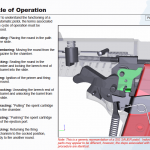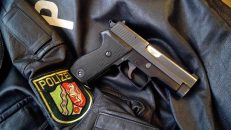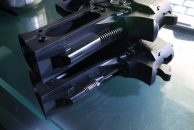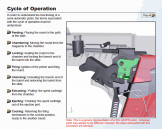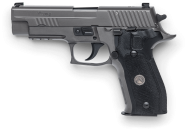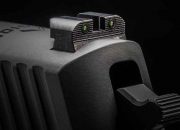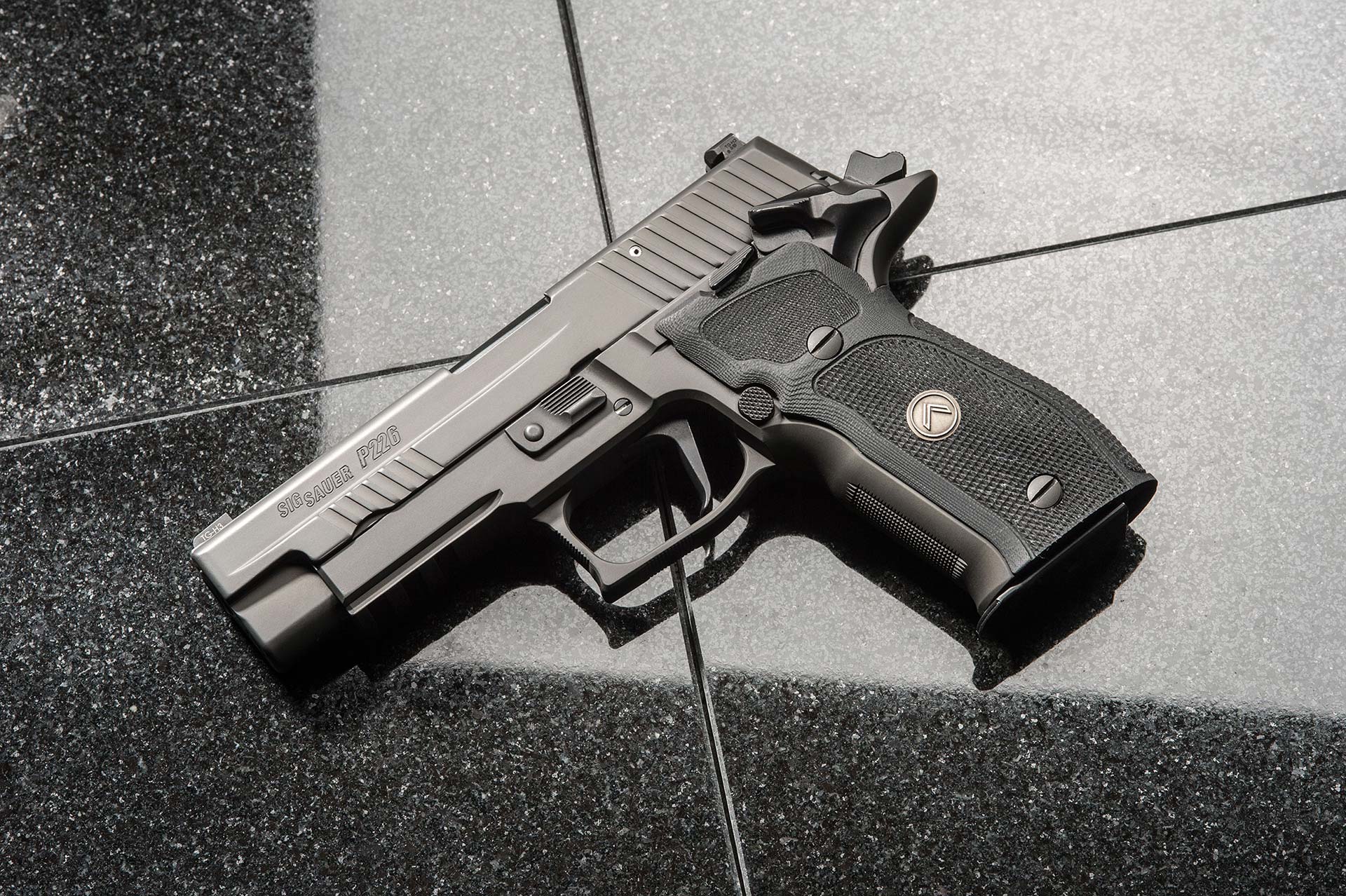
I see this question asked all the time on social media like the SIG Sauer Legion Facebook Group and SIG Sauer Facebook group. “Which SIG Legion should I get? SAO or DA/SA?” And the answer is (or at least should be) always the same: it depends.
There are plenty of fans of both action types, and so the answer you’ll get from someone else will be influenced by the type they personally own, in an effort to justify their own purchase. But whether the Single Action Only (SAO) or Double Action/Single Action (DA/SA) is the best choice for you really depends up a few factors, so let’s talk about them.
Differences Between the Legion SAO & DA/SA
To help us identify the differences between the SAO and DA/SA SIG Sauer Legions, let’s look at some photos. First, here’s the P226 Legion SA/DA:
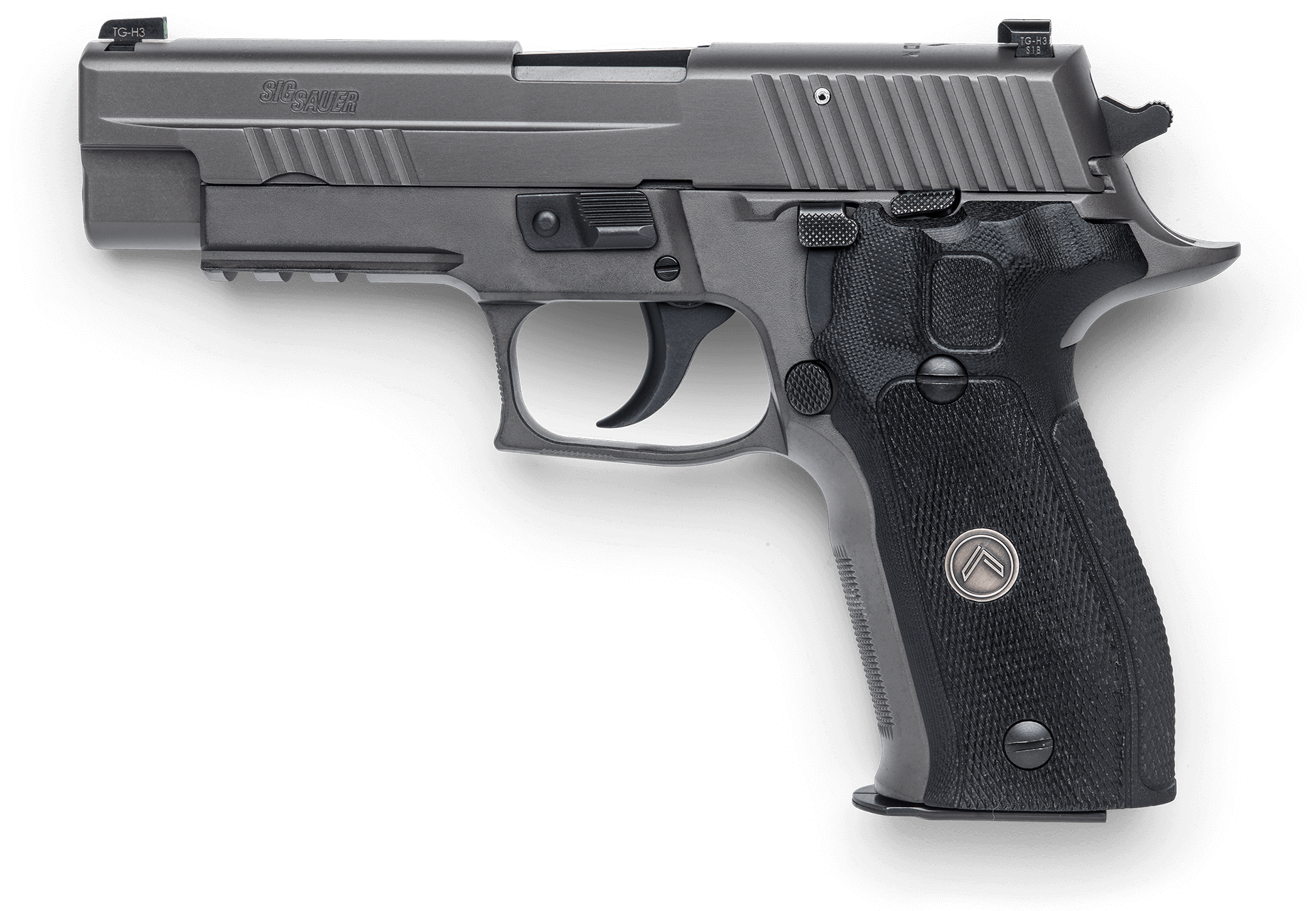
SIG Sauer P226 Legion DA/SA
And here’s the SIG Sauer P226 Legion SAO:
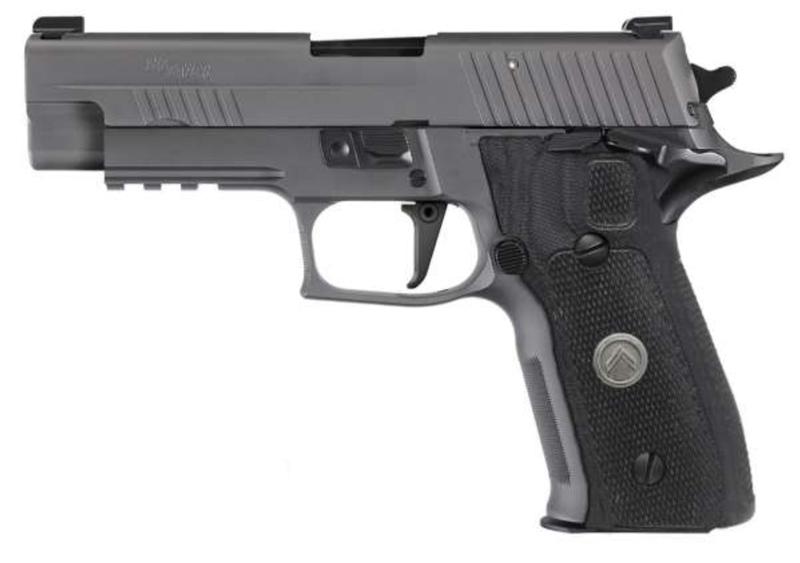
SIG Sauer P226 Legion SAO
SIG also offers the P220 Legion in DA/SA and SAO, with the same differences between the versions as the P226 Legion. There are actually three primary differences between the DA/SA and SAO models:
- Action
- Safety
- Trigger
Let’s look at each of these differences more closely, and discuss how they might affect your choice of which SIG Legion is right for you.
Difference #1: Legion SAO vs. DA/SA Action
Most of the action differences between the two versions can’t be identified visually, but the action is most important distinction between it impacts the other two differences I mentioned: the trigger and the safety.
Abbreviated Discussion of How a SIG DA/SA Action Works
I won’t explain everything that happens in a SIG Sauer DA/SA action because it involves internal safety mechanism, springs, plungers, a trigger bar and safety lever, an ejector and extractor, and a whole bunch of other things that are sufficiently explained elsewhere. But hopefully this “abbreviated” version of how a DA/SA action works will give you a brief overview of the basics of what happens.
In an uncocked state (hammer down), the trigger on a DA/SA pistol sits in its fully forward position. The shooter must apply 10 pounds of force to fire the initial shot, also referred to as the “double action shot.” Those 10 pounds of pulling force move the hammer back to its cocked position. As the trigger pull continues, the sear releases the hammer onto the firing pin, firing the chambered round. The rearward momentum of the slide created by the gasses from the fired round has enough force to (among other things) push the hammer and sear back to their cocked positions. The sear then re-engages the hammer to hold it in its cocked position and the trigger “resets” forward ready for the next shot. But the trigger doesn’t reset to the fully forward (uncocked) position — it resets just slightly forward (held in place by the trigger bar). The pistol is now ready for a “single action shot.” Because the action is already cocked, only 4.4 pounds of force is required to move the sear enough to drop the hammer on the firing pin and fire the round. The “double action” pull is so named because it does two things: cock the action and fire the round. The “single action” pull only has to do one thing — fire the round — because the action is already cocked by the slide movement from the previous shot.
Here’s an animated representation of a SIG Sauer DA/SA action firing a double-action shot then a single-action shot:
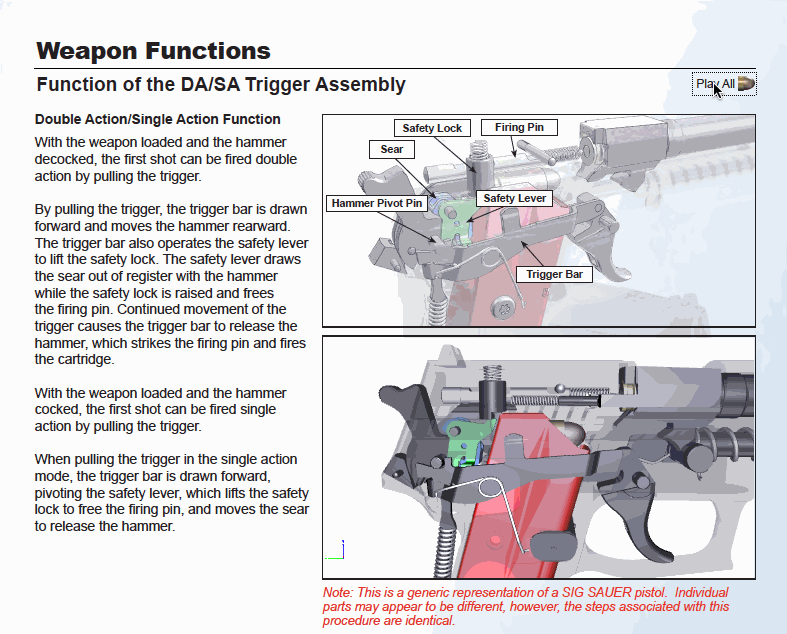
Animated representation of a SIG Sauer DA/SA action
With a DA/SA pistol, it’s also possible to cock the action by manually pulling the hammer back to the cocked position, which also pulls the trigger back to the “single action” position. The pistol would then be in single action mode, and 4.4 pounds of trigger pull would send the chambered round.
Abbreviated Discussion of How a SIG SAO Action Works
A SAO version of a pistol operates, as its name implies, only in single action mode. The action must be cocked manually before its initial round can be fired. Pulling on the trigger of an SAO pistol in an uncocked state does nothing. Once the pistol is cocked and the initial round fired, the rearward momentum of the slide cocks the action for subsequent shots, just as it does with a DA/SA pistol.
Because the SAO version doesn’t have a decocker it must be manually decocked by pulling back the hammer with the thumb, squeezing the trigger, and slowly lowering the hammer to the uncocked position. This can be a safety issue, so it’s important to follow the basic firearms rules when doing this and making sure that the firearm is always pointed in a safe direction.
DA/SA Decocker
Another action-specific difference between the DA/SA and SAO is that the DA/SA action includes a decocker lever, while the SAO version doesn’t.
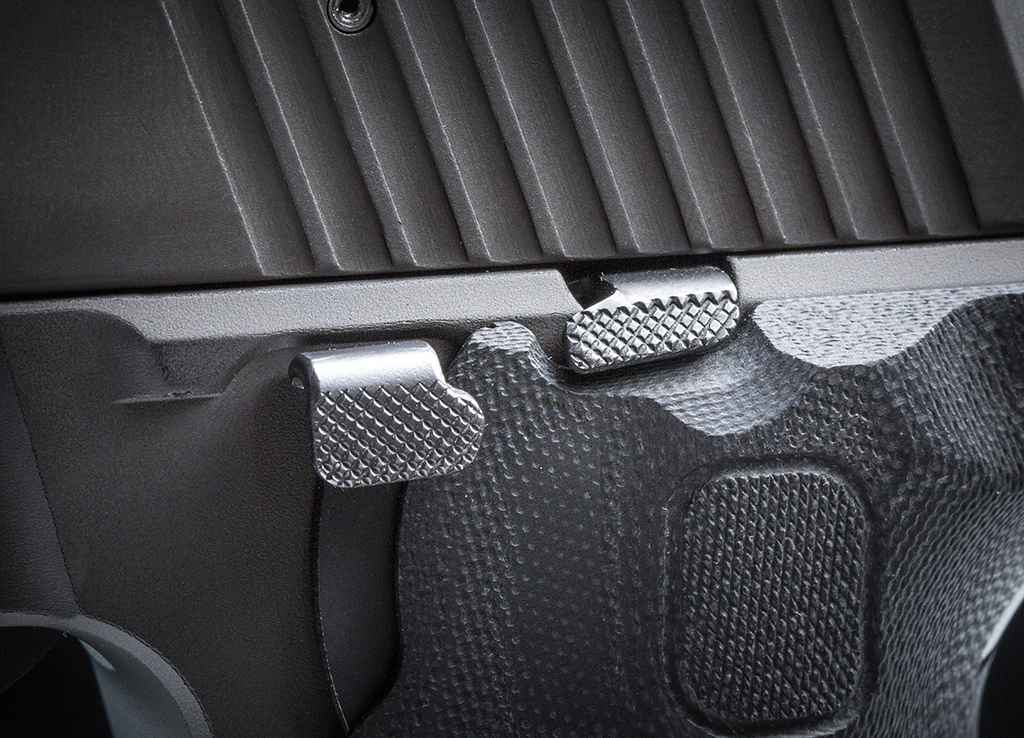
P226 Legion DA/SA decocker
The DA/SA decocker does nothing when the pistol is in double-action mode, as the pistol is already decocked. But in single-action mode, after firing or manual cocking, pressing down on the decocker lever safely uncocks the action by moving the trigger bar (and therefore the trigger) back to its fully forward position and lowering the hammer without impacting the firing pin.
DA/SA SRT Kit vs. SAO SRT Kit
Another difference between the actions of the DA/SA and SAO Legions is their implimentation of SIG’s Short Reset Trigger Kit. You can read this article to learn more about what an SRT Kit does, but in basic terms it shortens the amount of “reset” between shots (if you’re unfamiliar with trigger terminology like “reset,” read my Trigger Terminology).
The DA/SA comes with SIG’s traditional (and extremely popular) standard SRT KIT. Prior to the Legion line, SRT Kits weren’t available for SIG’s SAO pistols, as most shooters were satisfied with the inherently short reset that comes with SAO actions. However, SIG Sauer informed me that the SAO Legion is the first SAO SIG pistol to come with their new SAO SRT Kit. Whether or not they choose to sell the SAO SRT Kit separately as they do their DA/SA SRT Kit remains to be seen, by I imagine that if they did, it would be very well received (hint, hint!).
Difference #2: Legion SAO External Safety vs. DA/SA
Looking at the above photos, you can see that the P226 Legion SAO has an external ambidextrous thumb safety, while the P226 Legion DA/SA does not. Here’s a closer look at the external safety on the SAO:
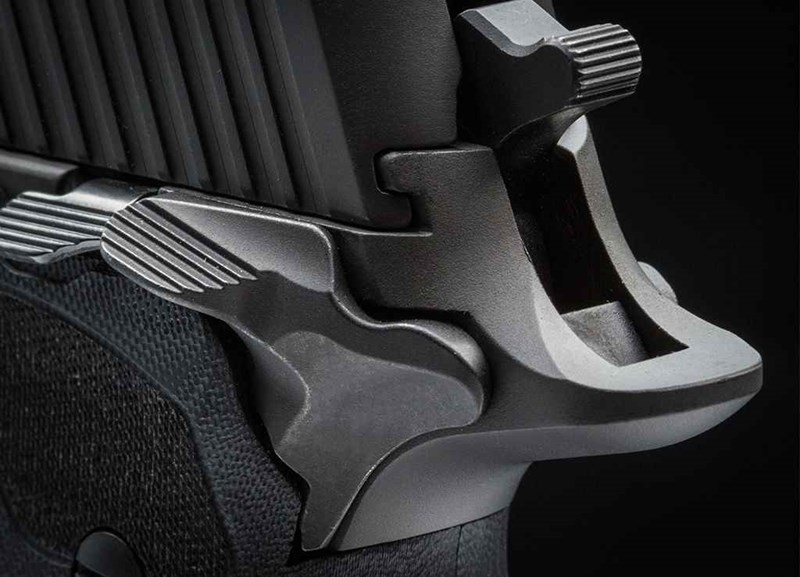
P226 Legion SAO safety (side view)
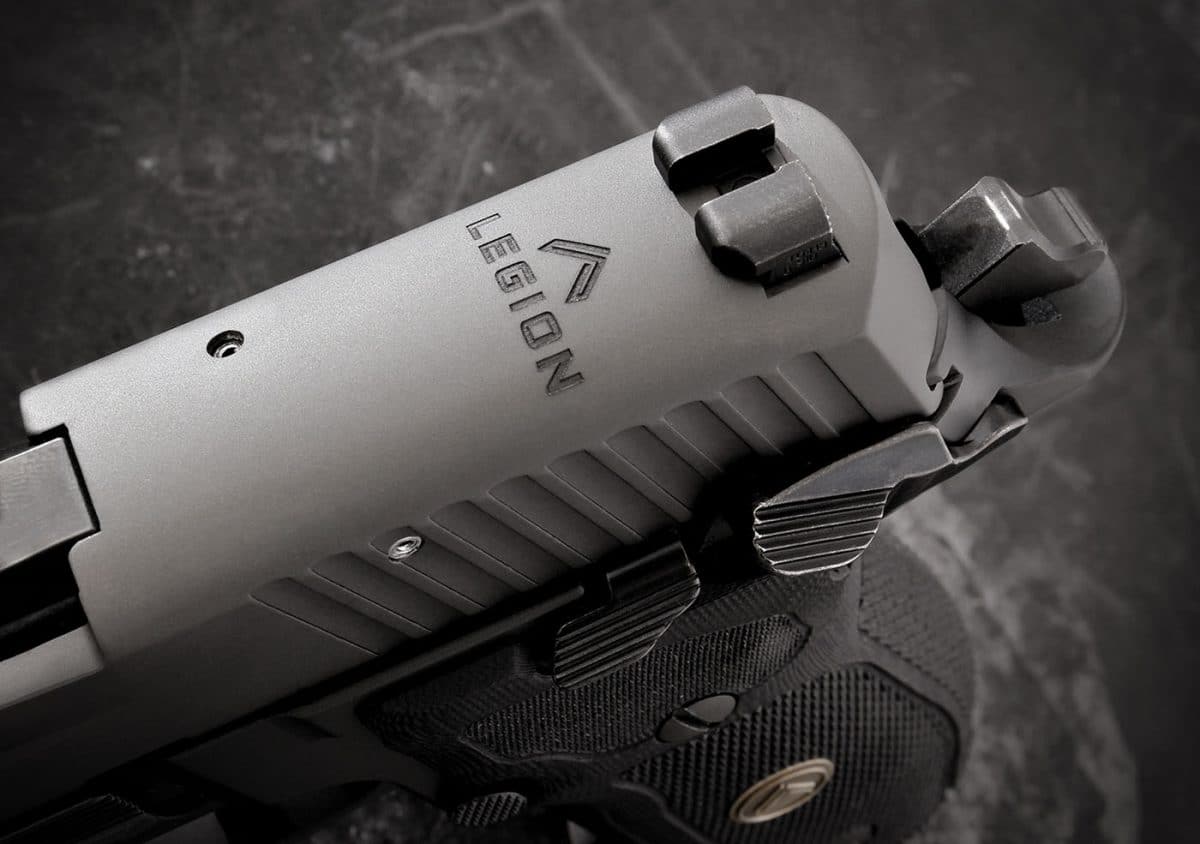
P226 Legion SAO safety (top view)
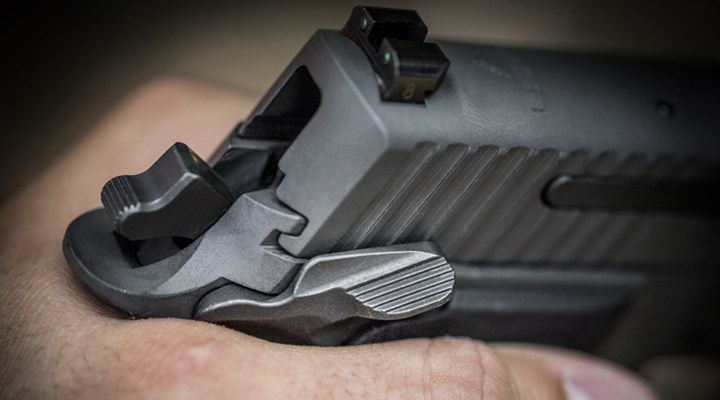
P226 Legion SAO safety (grip view)
The external ambidextrous thumb safety on the Legion SAO models operates like the thumb safety on a traditional 1911:
- the safety will only engage when the firearm is cocked
- click up to engage the safety
- click down to disengage the safety
However, unlike a traditional 1911 (or even a SIG Sauer X-Five SAO), the Legion SAO’s thumb safety does not lock the slide. This allows the shooter to clear the chamber without needing to disengage the safety.
Why the SAO has an External Safety while the DA/SA Doesn’t
Just because the DA/SA Legion doesn’t have an external safety doesn’t necessarily make it “less safe” than the SAO Legion. For those wishing to EDC an SAO SIG Sauer pistol, it’s advisable to do so in what’s called Condition 1: magazine inserted, round chambered, hammer back (meaning action is cocked), and safety on. The safety must be manually disengaged, putting the firearm in Condition 0, prior to applying 4.4 pounds of force to the trigger. This extra step gives the shooter an additional safeguard against bad decisions and possible negligent discharges. However, disengaging the safety is also an extra step that could be forgotten in a panic situation — costing the shooter valuable seconds if he/she pulls the trigger expecting a “bang,” but gets nothing. More than a few pheasants have lived to tell the tale of me doing this with a Remington 870 Wingmaster, in fact. So for those who wish to defensively carry an SAO firearm, training so that flicking off the thumb safety is a natural continuation of the draw stroke and presentation of the firearm is vital.
For those wishing to EDC a DA/SA SIG Sauer pistol, it’s advisable to do so in what’s called Condition 2: magazine inserted, round chambered, hammer forward (meaning the action is uncocked). The 10 pounds of force and additional trigger travel required to discharge a DA/SA firearm from Condition 2 are an essential part of its safety features. Like the requirement to disengage the safety on the SAO, the longer and more resistant DA pull is an additional safeguard against bad decisions and possible negligent discharges. Follow-up shots are all single-action shots, and will only require 4.4 pounds of force.
The argument as to which action type is “safer” has been raging since before Internet forums and Facebook groups existed. And the addition of striker-fired actions (like the Glock or SIG P320) to the conversation hasn’t done anything but fan the flames. You can watch all sorts of videos on YouTube that claim to compare the “safety” of all different types of firearm actions, but the best way to make any type of firearm action as safe as possible is to always keep your finger off the trigger until ready to fire.
Difference #3: Legion SAO Flat Trigger vs. DA/SA Grayguns P-SAIT Trigger
Much has been made of the Legion line’s triggers, and not without reason. They are, arguably, the feature that most set the Legion line apart from other SIG models, and that make the biggest impact on the guns’ performance.
The Legion DA/SA comes with a Grayguns P-SAIT trigger, which I demonstrate and install in any non-Legion SIG Sauer P-series pistol in this video. The primary features of the Grayguns P-SAIT are that it reduces the required “reach” of the shooter’s index finger to less than the standard SIG P-series trigger, but more than SIG’s newer “reduced reach” trigger — which is why the “I” in “P-SAIT” stands for “intermediate.” It retains the curve of a traditional P-series trigger and will feel very familiar to owners of other P-series SIG pistols. The P-SAIT also comes with an over-travel adjustment screw (for a definition of over-travel, read my Trigger Terminology article). This adjustment screw does not allow you to adjust trigger pull weight or trigger distance. It only affects over-travel. Further, it’s set at the factory for the proper over-travel adjustment and shouldn’t need to be messed with on a factory SIG Sauer Legion.
The trigger on the Legion SAO is… well… it’s somewhat of a sticking point with a handful of eagle-eyed SIG enthusiasts. When the SIG P226 Legion SAO was first announced, this was the photo of the Legion SAO trigger on SIG’s website:
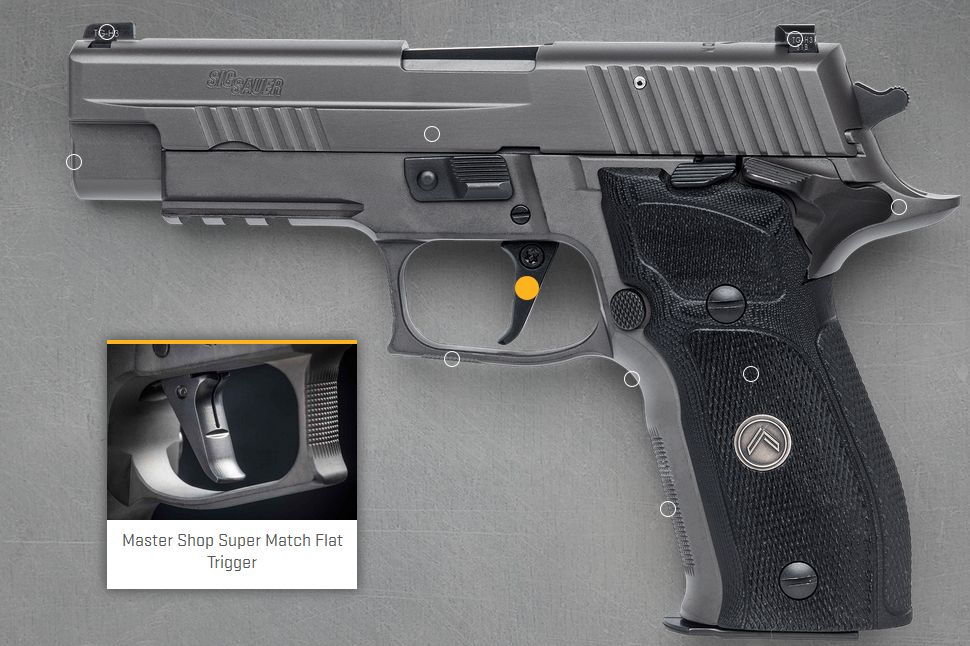
SIG Sauer P226 SAO marketing photo from SIG’s website, circa 2016
The trigger closeup shot is clearly marked “Master Shop Super Match Flat Trigger.” The Master Shop Super Match Flat Trigger is the one that comes on, as you might expect, match-grade pistols from SIG Sauer’s Master Shop, like this stunning X-Six:
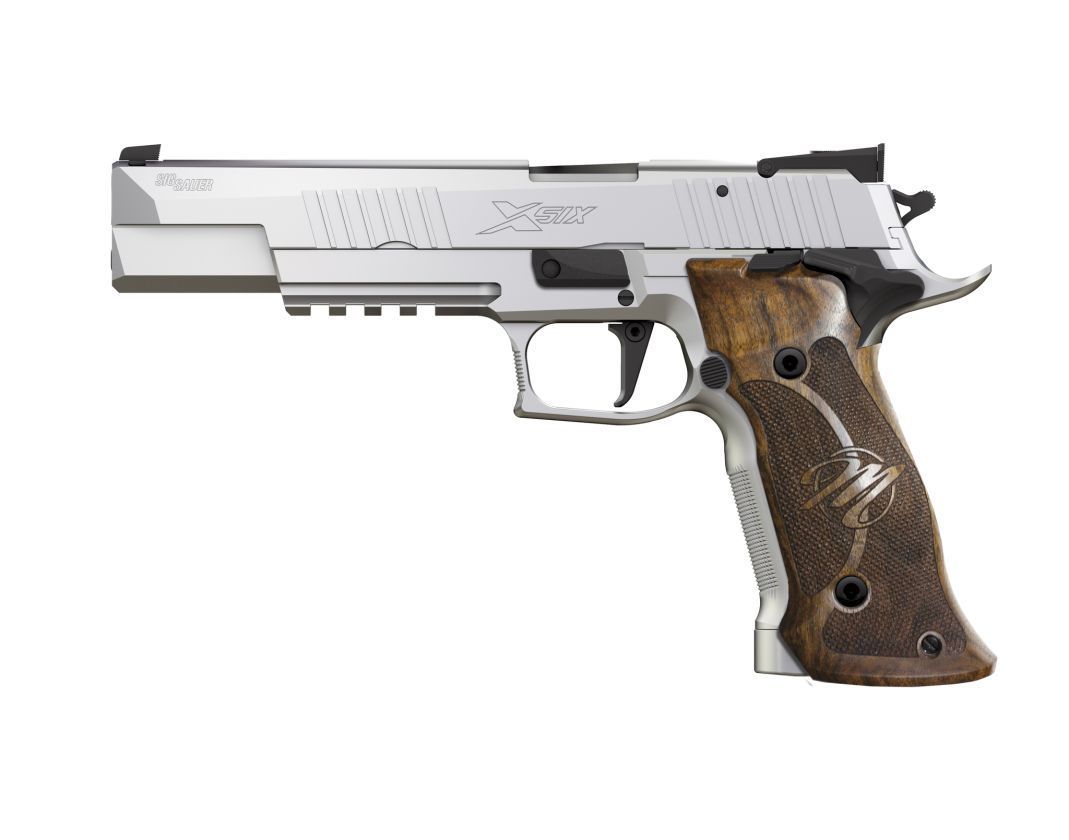
Note the adjustment screw on the trigger on both photos. On a SIG X5 or X6 pistols with that trigger, that adjustment screw adjusts the position of the trigger, but not the pull weight — which is actually adjusted in a different location on pistols that offer that feature.
But when P226 Legion SAOs started showing up in gun shops, they didn’t have the adjustment screw shown in those photos. And now, SIG has updated their website so that the P226 SAO now looks like this:
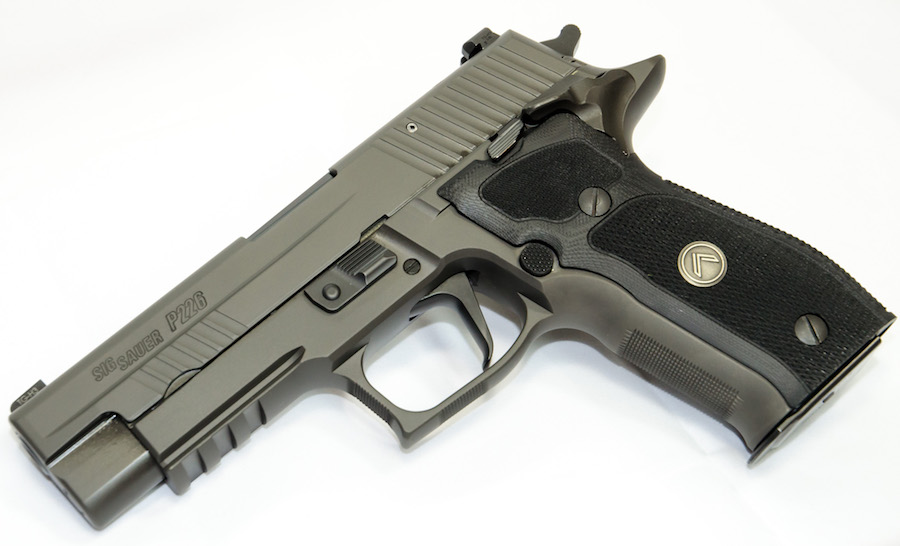
P226 Legion SAO as it actually shipped
Notice anything missing? Yep. There’s no adjustment screw. Which mean’s that’s not actually a Master Shop Super Match Flat Trigger. Not even close.
So what is it? As far as I can tell, it’s a custom flat trigger made exclusively for the SIG P226 Legion SAO. It’s not available for sale by any third parties and only fits the SIG Legion SAO. It cannot be fitted to the Legion DA/SA (or any other DA/SA pistol). Nor can it be fitted to any other SIG non-Legion SAO pistol, as apparently it’s mated to a customized SAO action sold only in the Legion line.
Questions about whether you can put the Legion SAO’s flat trigger on other SIGs come up all the time, so I’m going to say it again. In bold. In all capital letters.
THE SIG LEGION SAO FLAT TRIGGER CANNOT BE FITTED TO THE LEGION DA/SA OR ANY OTHER SIG DA/SA OR SAO PISTOL.
This custom flat trigger apparently requires a custom SAO action that’s only available in the Legion, which is different than the SAO action on SIG X-series pistols. I assume SIG did this as a way to keep the SIG Legion SAO models cost effective, as plopping in an X5 SAO action would make the price skyrocket. So they developed a less-expensive SAO action for the Legion line and mated this custom flat trigger to it.
Flat triggers are difficult to make work properly on DA/SA pistols anyway, since the length of the double-action trigger pull would mean that if the trigger started out in a vertically straight position in double-action mode, it would end up in download diagonally sloping position in single-action mode, which makes it difficult to maintain proper finger position. And in order to end up perfectly vertical in single-action mode, it would start out sitting in an upward sloping diagonal position in double-action mode, which would make it difficult to get your finger inside the trigger guard for the first double-action shot. Nobody (yet?) has figured out how to solve these problems, and regardless of the rumors of third-party prototypes I’ve read about on gun forums, there is no flat trigger for DA/SA SIG Sauer pistols currently on the market. If you want a flat trigger on a SIG, you’ll need to buy an SAO pistol.
One More Minor Difference
This final difference between the Legion SAO and Legion DA/SA doesn’t affect the functionality like the action, safety, or trigger, but it’s still a difference and deserves at least a small mention.
The Legion SAO version’s frame, much like the X5 SAO frame, has an attachment point at the bottom of its magazine opening where an aftermarket magwell can be attached, which (in my opinion) upgrades the SAO version’s looks:
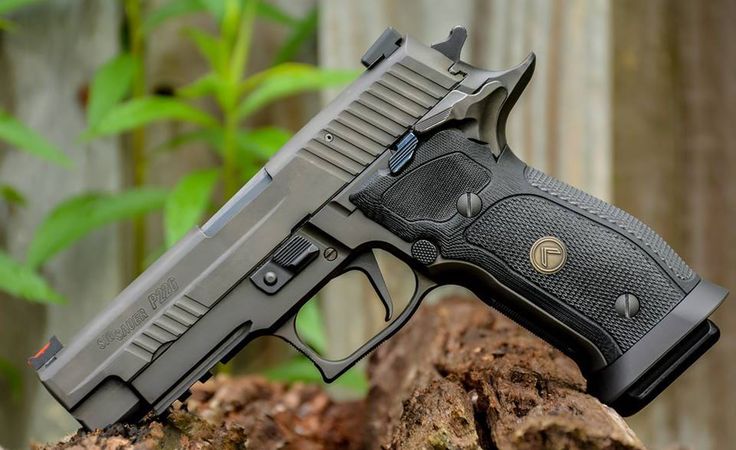
P226 Legion SAO with aftermarket magwell
So Which Legion Should I Get? DA/SA or SAO?
Now that you understand the three primary differences between the SIG Sauer Legion DA/SA and SAO — action, safety, and trigger — you’re in a better position to decide which is best… for you. But don’t trust anyone else to tell you which is “best,” because “best” actually should mean “best for you” and should depend on your personal preferences and how you plan to use it.
Personally, I love SAO SIGs — but I don’t like carrying defensive guns with external safeties. I have nothing bad to say about people who do. It’s merely my personal preference, based on my history and training. But I love target shooting SAO SIGs at a range. Quite frankly, both my X5 SAO and my P226 Legion SAO make my man-parts tingle when I shoot them. SAO SIGs are smooth, predictable, and scary accurate… as long as I remember to flick off the safety before I pull the trigger.
But because I don’t train with external safeties, I don’t want to stake my life on remembering to flick one off. I prefer the longer and deliberate pull of a heavy double-action initial shot, followed by quicker and lighter pull follow-up shots. But that also takes a lot of practice, as those new to DA/SA actions tend to put their first shot low and to the left unless they train past that.
SAO Legions are a popular choice at defensive pistol shooting matches… as long as their width is allowed (the Legion SAO is wider than the DA/SA because of the ambidextrous safeties). It’s possible to have the safety filed down so it complies with IPDA size regulations.
Hopefully this article has given you the information you need to help with your decision, but which Legion you should get is a question only you can answer. If you can, shoot one of each before you decide, then pick the one that feels better to you and that fits the way you plan to use it.
Or, if you have the means, buy both! Then come and make all of us in the SIG Sauer Legion Facebook group jealous when you post the side-by-side photos. 🙂
Si vis pacem parabellum, and stay safe out there!
As always, I welcome your questions, comments, and feedback below.


